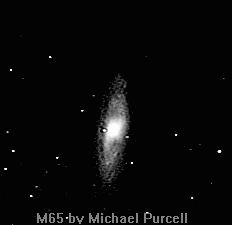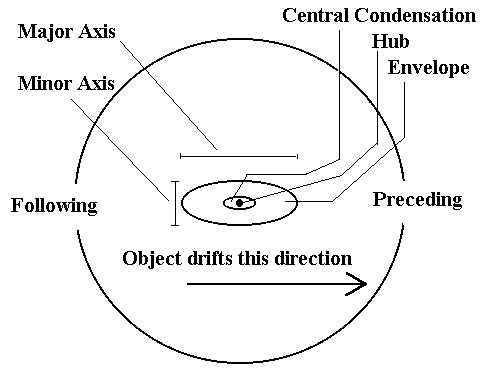Describing a Galaxy
Jack Kramer
Let's say you've just observed the galaxy shown below. The following picture is a CCD image of M65 by Michael Purcell. If you squint your eyes as you look at it, the image takes on more of the visual appearance it would have in a modest-sized telescope. As you make some notes about it in your observation records, are you wondering how best to describe what you see?

In order to compare your observation with others or with a photo of the object, it's helpful to have a consistent way of describing features. Based on a variety of sources, I've adopted what appears to be a generally-used format, though by no means are these terms employed by all observers.
For example, many galaxies have a small bright central hub; this may look like a hazy star at the apparent center of the galaxy. A larger area at the center that appears brighter than the rest may be referred-to as a central condensation. The central condensation is all that many observers in light polluted areas can see of the large galaxy M31 in Andromeda. And it's not uncommon to observe a galaxy that has a bright, starlike hub within a bright central condensation. I refer to the outer area of the galaxy as the envelope, though some prefer the term disk.
Other details within the envelope may be described in terms of their positions with respect to the long (major) or short (minor) axes of the galaxy. (Of course, this nomenclature won't work on perfectly face-on galaxies.) Edge-on galaxies, in particular, often exhibit a brighter or darker line running along the major axis. A dark line might be an absorption feature, such as a dust or gas cloud in the plane of the galaxy - the Sombrero Galaxy (M104) is an excellent example of this. A brighter line might be the central bar if the galaxy is a barred spiral. If the brightness of the envelope is not uniform, this is referred-to as mottling, which may be an indication of star clouds, HII regions, or unresolved spiral structure. A few galaxies such as M51, M101, and M83 are notable for having spiral structure that's easy to see in moderate-sized amateur instruments in a dark sky. And M31 and M101 are examples of galaxies that contain discrete star clouds that sport their very own NGC numbers. The margins are the outermost edges of the envelope. The brightness of the envelope often fades off at the edges, so we may not be able to tell where it really ends; we can refer to the margins as "poorly defined" or "indistinct". On the other hand, some galaxies have uniformly bright envelopes, or a margin might be more sharply defined on one side of the galaxy. This latter situation may indicate an absorption feature toward the edge of the galaxy.
Certain aspects are commonly identified by their orientation with respect to the galaxy as it appears in the telescope. If you let the galaxy drift across the field of view, the preceding edge is the side that goes out of the field first, while the following edge is the side that disappears out of the field last. You would also want to determine which direction is north and which south as you view the object; this depends on the configuration of your scope. If you move your telescope a bit in the direction of Polaris, the side of the galaxy that disappears last will be the "north" side. Nearby stars are recorded with their orientation in case one of them happens to be a supernova in the galaxy - a star that normally isn't there. A field star might be recorded by saying, for example, that it "lies at the north preceding edge" of the galaxy. A more accurate way to identify direction is by reference to the degrees from the galaxy's apparent north, but I find this cumbersome.

Getting back to M65, our record might look something like the following: "Bright central condensation within elongated envelope. Faint stars at opposite ends of minor axis. Margins indistinct at ends of major axis" Assuming the galaxy drifts to the right, we might use different wording and say: "Faint stars lie at preceding and following edges of envelope".
Although the focus here has been on galaxies, a few of the terms can be adopted for nebulae and star clusters. The bottom line is that you should consistently use whatever terms you find appropriate for describing what you see. Adopt your own repertoire, so that when you want to record a beautiful galaxy, you won't be forced to say "words fail me"!
Published in the April 1996 issue of the NightTimes




